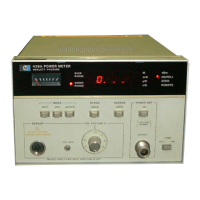Operation
3-64.
Sources of Error and Measurement
Uncer-
tainty
3-65.
RF Losses.
Some
of
the
RF
power
that
enters the
Power
Sensor
is
not
dissipated in the
power sensing elements. This
RF
loss
is
ca.used
by
dissipation in
the
walls of waveguide power
sensors,
in
the
center conductor
of
coaxial power
sensors,
in
the
dielectric
of
capacitors, connections
within the sensor, and radiation losses.
3-66.
Mismatch. The result
of
mismatched
impe-
dances between
the
device under test and
the
power sensor is
that
some
of
the power fed
to
the
sensor
is
reflected before it
is
dissipated in
the
load. Mismatches affect the measurement in two
ways. First,
the
initial reflection
is
a simple loss
and
is
called mismatch loss. Second,
the
power
reflected from the sensor mismatch travels back up
the transmission line until it reaches
the
source.
There, most
of
it
is
dissipated in
the
source
impedance,
but
some
of
its re-reflected by the
source mismatch. The re-reflected power returns
to
the power sensor and adds to,
or
subtracts from,
the incident power. For all practical purposes,
the
effect the re-reflected power has upon the power
measurement is unpredictable. This effect
is
called
mismatch uncertainty.
3-67.
Instrumentation Uncertainty. Instrumenta-
tion uncertainty describes
the
ability
of
the
meter-
ing circuits
to
accurately measure the de
output
from the
Power Sensor's power sensing device. In
the
Power
Meter this error
is±
0.53
for Ranges 1
through
5.
It
is
important
to
realize, however,
that
these uncertainty specifications do
not
indicate
overall measurement accuracy.
3-68.
Power Reference Uncertainty.
The
output
level
of
the
Power Reference Oscillator
is
factory
set
to
1 mW±
0.703
at
50
MHz.
This reference
is
normally used
to
calibrate the system, and is,
therefore, a
part
of
the
system's total measurement
uncertainty.
3-69.
Cal
Factor Switch
Resolution Error. The
resolution
of
the
CAL
FACTOR % switch
contributes a significant error to the total
measurement because the switch has 1
%
steps. The
maximum error possible
in
each position
is
±0.53.
3-70.
Corrections for Error
3-71. The
two
correction factors basic to power
meters are calibration factor and effective
efficiency. Effective efficiency
is
the correction
3-30
Model 436A
factor for
RF
losses within
the
Power
Sensor.
Calibration factor takes into account
the
effective
efficiency and mismatch losses.
3-72. Calibration factor
is
expressed
as a
percentage with
1003
meaning
the
power sensor
has no losses. Normally
the
calibration factor will
be
100%
at
50
MHz,
the
operating frequency
of
the
internal reference oscillator.
3-73. The
Power Sensors used with
the
Power
Meter have individually calibrated calibration
factor curves placed on their covers.
To
correct for
RF
and mismatch losses, simply find
the
Power
Sensor's calibration factor
at
the
measurement
frequency from the curve
or
the
table
that
is
supplied with
the
Power Sensor and set
the
CAL
FACTOR % switch
to
this value. The measurement
error due
to
this error
is
now minimized.
3-74. The
CAL
FACTOR % switch resolution
error
of
±0.53
may be reduced
by
one
of
the
following methods:
a.
Leave
the
CAL FACTOR % switch on
..100%
after calibration,
then
make
the
measure-
ment
and record
the
reading.
Use
the
reflection
coefficient, magnitude and phase angle from
the
table supplied with
the
Power Sensor
to
calculate
the
corrected power level.
b.
Set
the
CAL FACTOR % switch
to
the
nearest position above and below
the
correction
factor given on
the
table. Interpolating between
the
power levels measured provides
the
corrected
power level.
3-75.
Calculating
Total Uncertainty
3-
7 6. Certain errors in calculating
the
total
measurement uncertainty have been ignored in this
discussion because
they
are beyond
the
scope
of
this manual. Application Note AN-64,
"Microwave
Power
Measurement",
delves deeper into
the
calcu-
lation of power measurement uncertainties.
It
is
available,
on
request, from
your
nearest
HP
office.
3-77.
Known
Uncertainties.
The known
uncer-
tainties which account for
part
of
the
total power
measurement uncertainty are:
a.
Instrumentation
u~certai.'1ty
:f:
0.5%
er
±0.02
dB
(Range 1 through 5).
b.
Power
reference uncertainty
±0.73
or
±0.03
dB.
••
•

